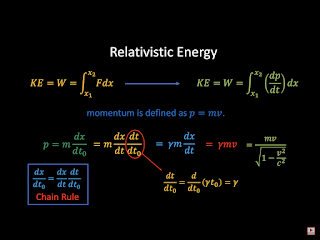In classic mechanical physics, work is equivalent to energy: work is equal to the product of force and distance put into it.
W (work) = F (force) x D (distance) so E (energy) = F x D
But F = M x A so Work (Energy): E = M x A x D
But A = V/T so Energy E = M x V/T x D
But V = D/T so E = M x D/T/T x D = M x D squared/ T squared
But velocity = D/T, so D squared / T squared = V squared.
So E = M x V squared. That is the kinetic energy formula.
Many times that kinetic formula is written for the average of kinetic energy:
E = 1/2 M V squared
That would be accomplished by measuring the kinetic energy at two different points in time, adding them for a sum, and then dividing that sum by two to get the average.
Albert Einstein used the "C" in his formula instead of ordinary "V" to stress the speed of light, which cannot be exceeded. Therefore the maximum energy state to which that mass could ever attain has an upper limit.
One thing the reconstituted formula expresses that is not particularly evident in the original W = F x D formula is that mass, even apart from motion, is a reservoir for a tremendous amount of energy. It anticipated that if any mass were lost in a process, that process would feature that phenomenal energy release.



